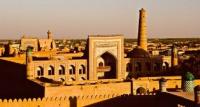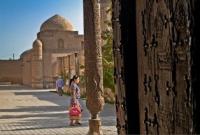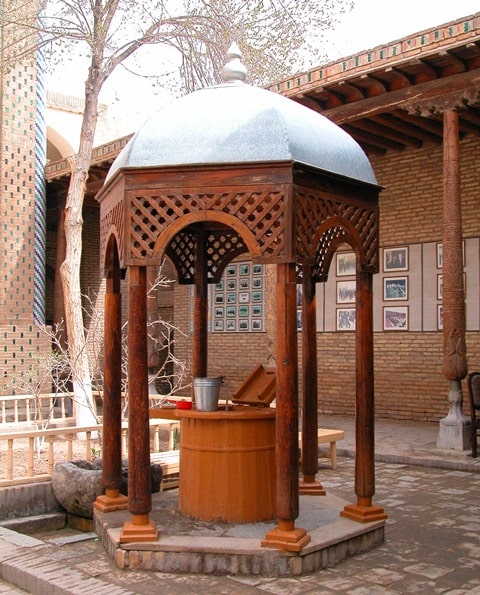You are here
Architecture of Khorezm.


Tours of architectural monuments of Khorezm.
“This is the greatest, most beautiful, largest city of the Turks with beautiful bazaars, wide streets, numerous buildings and impressive views. The city is full of life thanks to a large number of residents, and it seems to be a worried sea”
Tours from Mangystau region to Khorezm.
In the rural architecture of Khorezm, the most common type of housing is the manor (hauli). It is appropriate to recall the description of this kind of Khiva manor, made by A. Kalmykov as early as the beginning of the XIXth century: “Khiva people do not live in villages, but as separate estates.
Each house represents a small fortress. The walls, slightly sloping, are very high. Huge gates are built into the wall, as in a fortress. Near the gate, in the corners and along the facades, at a distance of four or five fathoms, the walls are fortified with round clay pillars in the form of buttresses.
The first courtyard is covered It is called dal. Further, an open courtyard with a canopy on the column (iwan). This canopy has a living room (shed), near it there is a dark storage room for storage of household goods (bills). Sometimes the courtyard is covered, if it is small ... "
The cult architecture of Khiva is represented by mosques, madrasas and mausoleums of various sizes. Especially numerous small mosques, evenly located in the city. The architecture of mosques is born as if in a combination of frame and dome-vaulted systems of structures.
Many mosques have Square rooms in plan - the khanaka and the aivans adjoining them. Hanaka could have a dome cover. Khiva madrassas are diverse. In the framework of traditional courtyard compositions with a portal entrance, one-story, two-story and combined madrasas are varied.
The Khiva masters created ornamental compositions unsurpassed in subtlety of drawing, especially in carving on the Tree. Polychrome majolica was widespread. The majolica facings of the Tash-Khauli palace complex and the Pakhlavan Makhmud mausoleum are made with great artistic taste.
Although Khorezm did not use monumental painting as widely as in Bukhara, Samarkand and Kokand, however, the ceiling and wall paintings were distinctive and original in their interpretation. The patterned color inserts of the paintings organically fit into the architecture.
Khorezm builders enjoyed the fame of genuine masters of the construction of impressive pahsovnyh structures. Pakhsa is a massive clay wall, the most accessible and practical construction known in Khorezm since ancient times.
The surface of the pakhasa during leveling can be processed plastically, creating vertical rows of flutes, separate ornamental compositions with thread. Plastics of deep carving gives pakhse a special monumentality and expressiveness.
The best examples of pakhsa can be observed in Khiva estates - hauli, as well as the country palaces of the rulers - Rafanik, Nurullabay, Tazabag. In every ancient city of Uzbekistan, perhaps, one can see peculiar pillars of history - minarets.
Majestically and proudly rise vertical architectural volumes. Often associated with them are folk legends, where they found a romantic reflection of thoughts and dreams of perfection and the attractive power of the architect’s art, of the height of inspired creativity, and sometimes deep sadness about the tragic fate of the creators of the truly beautiful.
There is a legend in Bukhara that their architect, having laid the last stone on the top of the Kalyan minaret, flew away towards Khorezm, because he was warned about the insidious plan of a cruel ruler who intended to kill him and thus forever prevent the emergence of another such minaret that would compete with Bukhara.
In ancient Urgench they say that their architect flew away from the top of the minaret just completed, and it is not known exactly where he went: maybe he was in Bukhara or Samarkand. Minarets are diverse in architectural form and occupy an important place in the spatial panorama of mass building, bringing a certain organizing, tectonic and artistic beginning and originality in the architectural appearance of the eastern city.
In this sense, the Khiva minarets are large and small, surprisingly diverse in form to the decor. Traditionally, a minaret was built at each mosque. If we consider that more than 50 mosques have survived in Khiva, it will become clear why minarets are so often found in the city.
Among the minarets is the highest (44.5 m) and perfect in architecture - Islam Khoja minaret. Its diameter at the base is 9.5 m. It is the last in time (1908) monument of the minaret of this dimension. The second highest minaret at the Juma mosque was built at the end of the 18th century.
Unlike other minarets of Khiva, it is almost not decorated.

Authority:
«Khiva city and legends» the tourist guidebook across Khiva”.







